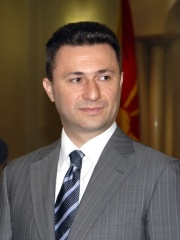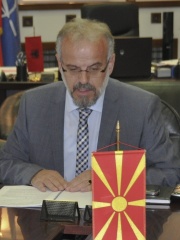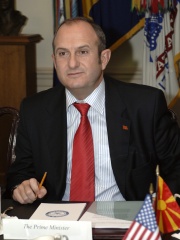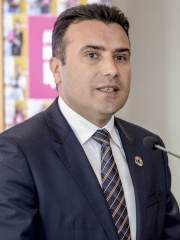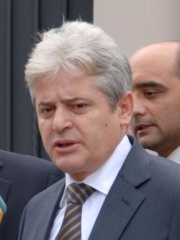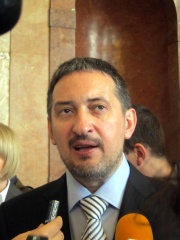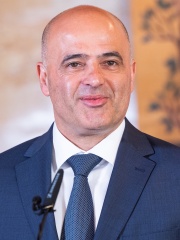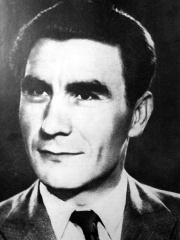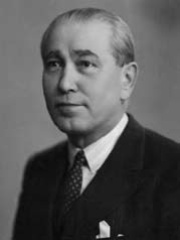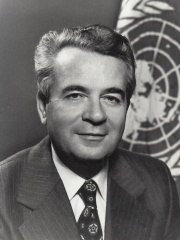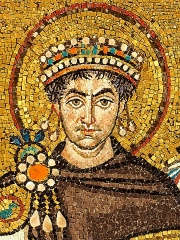
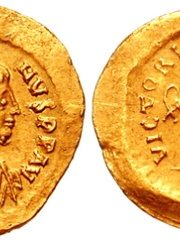
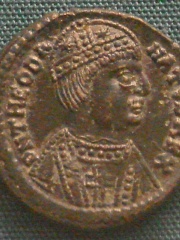
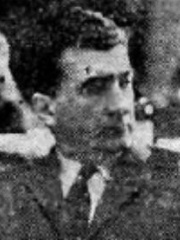
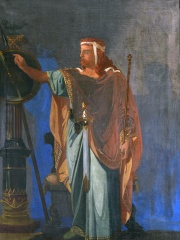
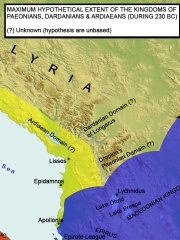
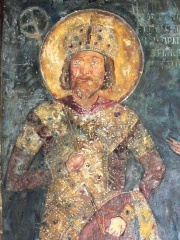
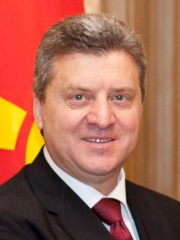
The Most Famous
POLITICIANS from North Macedonia
This page contains a list of the greatest Macedonian Politicians. The pantheon dataset contains 19,576 Politicians, 42 of which were born in North Macedonia. This makes North Macedonia the birth place of the 76th most number of Politicians behind Iceland, and Ecuador.
Top 10
The following people are considered by Pantheon to be the top 10 most legendary Macedonian Politicians of all time. This list of famous Macedonian Politicians is sorted by HPI (Historical Popularity Index), a metric that aggregates information on a biography's online popularity. Visit the rankings page to view the entire list of Macedonian Politicians.

1. Justinian I (482 - 565)
With an HPI of 85.69, Justinian I is the most famous Macedonian Politician. His biography has been translated into 101 different languages on wikipedia.
Justinian I (Latin: Iustinianus, Ancient Greek: Ἰουστινιανός, romanized: Ioustinianós; 482 – 14 November 565), also known as Justinian the Great, was Roman emperor from 527 to 565. His reign was marked by the ambitious but only partly realized renovatio imperii, or 'restoration of the Empire'. This ambition was expressed by the partial recovery of the territories of the defunct Western Roman Empire. His general, Belisarius, swiftly conquered the Vandal Kingdom in North Africa. Subsequently, Belisarius, Narses, and other generals conquered the Ostrogothic Kingdom, restoring Dalmatia, Sicily, Italy, and Rome to the empire after more than half a century of rule by the Ostrogoths. The praetorian prefect Liberius reclaimed the south of the Iberian Peninsula, establishing the province of Spania. These campaigns re-established Roman control over the western Mediterranean, increasing the Empire's annual revenue by over a million solidi. During his reign, Justinian also subdued the Tzani, a people on the east coast of the Black Sea that had never been under Roman rule before. He engaged the Sasanian Empire in the east during Kavad I's reign, and later again during Khosrow I's reign; this second conflict was partially initiated due to his ambitions in the west. Justinian is regarded as one of the most prominent and influential Roman emperors. One of the most enduring aspects of his legacy was the uniform rewriting of Roman law, the Corpus Juris Civilis, which was first applied throughout the Eastern Mediterannean and is still the basis of civil law in many modern states. His reign also marked a blossoming of Byzantine culture, and his building program yielded works such as the Hagia Sophia.

2. Justin I (450 - 527)
With an HPI of 76.33, Justin I is the 2nd most famous Macedonian Politician. His biography has been translated into 59 different languages.
Justin I (Latin: Iustinus; Ancient Greek: Ἰουστῖνος, romanized: Ioustînos; c. 450 – 1 August 527), also called Justin the Thracian (Latin: Iustinus Thrax; Ancient Greek: Ἰουστῖνος ὁ Θρᾷξ, romanized: Ioustînos ho Thrâix), was Roman emperor from 518 to 527. Born to a peasant family, he rose through the ranks of the army to become commander of the imperial guard and when Emperor Anastasius I Dicorus died, he out-maneouvered his rivals and was elected as his successor, in spite of being around 68 years old. His reign is significant for the founding of the Justinian dynasty that included his nephew, Justinian I, and three succeeding emperors. His consort was Empress Euphemia. Justin was noted for his strongly Chalcedonian Christian views. This facilitated the ending of the Acacian schism between the churches of Rome and Constantinople, resulting in good relations between Justin and the papacy. Throughout his reign, he stressed the religious nature of his office and passed edicts against various Christian groups seen at the time as non-Orthodox. In foreign affairs, he used religion as an instrument of state. He endeavoured to cultivate client states on the borders of the Empire, and avoided any significant warfare until late in his reign.

3. Theodahad (480 - 536)
With an HPI of 70.71, Theodahad is the 3rd most famous Macedonian Politician. His biography has been translated into 38 different languages.
Theodahad, also known as Thiudahad (Latin: Flavius Theodahatus Rex, Theodahadus, Theodatus; c. 480 – December 536), initially ruled the Ostrogothic Kingdom jointly with his cousin Amalasuintha. She elevated him to co-monarch in late 534, following the death of her son, King Athalaric, likely seeking male support to legitimize her regency. However, seeking sole power, Theodahad betrayed Amalasuintha; he had her imprisoned and subsequently murdered around April 30, 535. His tenure as sole ruler proved short and tumultuous, ending with his deposition and death in December 536 while fleeing the forces of his successor, Witiges. Theodahad's reign stands in stark contrast to the long and relatively stable rule of his uncle, Theodoric the Great, the kingdom's founder. Drawing on contemporary accounts (such as those by Procopius) and subsequent historical analysis, Theodahad's leadership is widely assessed as a disastrous failure. Key factors contributing to this view include his treacherous usurpation and murder of Amalasuintha—an act which provided Byzantine Emperor Justinian I with a direct pretext (casus belli) to launch the Gothic War—and his widely documented avarice, unpopularity with the Gothic nobility, and ineffective military leadership against the initial Byzantine invasion led by Belisarius. His failures ultimately precipitated a conflict that devastated Italy and led to the kingdom's destruction.

4. Kiro Gligorov (1917 - 2012)
With an HPI of 70.24, Kiro Gligorov is the 4th most famous Macedonian Politician. His biography has been translated into 48 different languages.
Kiro Gligorov (Macedonian: Киро Глигоров, pronounced [ˈkirɔ ˈɡliɡɔrɔf] ; 3 May 1917 – 1 January 2012) was a Macedonian and Yugoslav statesman, economist, and politician who served as the first president of the Republic of Macedonia (now North Macedonia) from 1991 to 1999. He was born and raised in Štip, where he was also educated. He continued his education in Skopje and graduated in law in Belgrade. During World War II in Yugoslav Macedonia, he worked as a lawyer and participated in the partisan resistance. By the end of the war, he was an organiser of the Anti-fascist Assembly for the National Liberation of Macedonia, the predecessor of the Socialist Republic of Macedonia as a federal Yugoslav state. After the war, he served in various positions in Yugoslavia. For decades, he was a high-ranking official and an economist there. Prior to the breakup of Yugoslavia, Gligorov was an adviser for Ante Marković's market reform plan. Gligorov later played a pivotal role in Macedonia's peaceful secession from Yugoslavia and its international recognition. In 1995, he survived an assassination attempt, of which the perpetrators have not been found. For his role in its independence and political development, international researchers and the Macedonian public regard him as the father of the Macedonian state.
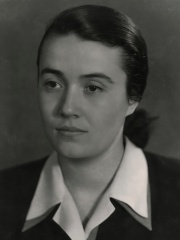
5. Nexhmije Hoxha (1921 - 2020)
With an HPI of 68.78, Nexhmije Hoxha is the 5th most famous Macedonian Politician. Her biography has been translated into 29 different languages.
Nexhmije Hoxha (Albanian pronunciation: [nɛdʒˈmijɛ ˈhɔdʒa]; née Xhuglini; 8 February 1921 – 26 February 2020) was an Albanian communist politician. She was the wife of Enver Hoxha, the first leader of the Socialist People's Republic of Albania and the First Secretary of the Party of Labour of Albania. Very close to her husband, she attempted to remain politically influential after his death in 1985. She was one of the few spouses of a ruling communist party leader with a high political profile of her own.

6. Sigeric (370 - 415)
With an HPI of 68.04, Sigeric is the 6th most famous Macedonian Politician. His biography has been translated into 39 different languages.
Sigeric (? – 22 August 415) was a Visigoth king for seven days in 415 AD.

7. Agron (0 - 230 BC)
With an HPI of 66.48, Agron is the 7th most famous Macedonian Politician. His biography has been translated into 22 different languages.
Agron (; Ancient Greek: Ἄγρων) was an Illyrian king of the Ardiaean Kingdom in the 3rd century BC, ruling c. 250–231 BC. The son of Pleuratus II, Agron succeeded in reconquering southern Illyria, which had been under the control of Epirus since the time of Pyrrhus, and in extending Illyrian rule over many cities in the Adriatic region, including Corcyra, Epidamnos, and Pharos. He is most famed for his decisive victory over the Aetolian League, a state in western Greece. Around 231 BC, Agron suddenly died after his triumph over the Aetolians. Pinnes, his son with his first wife Triteuta, officially succeeded his father as king in 231 BC, but the kingdom was ruled by Agron's second wife, Queen Teuta.

8. Konstantin Tih (1240 - 1277)
With an HPI of 65.45, Konstantin Tih is the 8th most famous Macedonian Politician. His biography has been translated into 27 different languages.
Constantine I Tih (Bulgarian: Константин I Тих, romanized: Konstantin I Tih) was the tsar of Bulgaria from 1257 to 1277, he was offered the throne from Mitso Asen. He led the Bulgarian Empire at a time when the nearby Byzantine Empire disintegrated into rump states. To strengthen his position, he forged an alliance with one of the rump states—Nicaea—by marrying Irene, a daughter of Theodore II of the prominent Laskaris family. Early in his reign, his army invaded Severin, Hungary which outraged Béla IV; this led Hungarian troops to capture Vidin, an important town of the Bulgarian Empire and also saw the Hungarians besieging the Lower Danube region, leaving northwestern Bulgaria to Rostislav Mikhailovich (Béla's son-in-law), who had claimed Bulgaria in the years prior. When Michael VIII took over the throne of the Byzantine Empire (which led Konstantin to go to war with them in the 1260s) this saw Bulgaria losing significant territories to its two principal enemies, the Byzantines and Hungary. Later, when Tatars began attacking the Byzantines, Konstantin joined them in a unified attack but this failed to capture Michael VIII. After Stephen emerged victorious in the Hungarian civil war, he began attacking Bulgaria again and defeated Konstantin's army. He plundered Tarnovo and captured fortresses on the Danube in the mid to late 1260s. Later, Konstantin suffered an injury and was paralysed from the waist down. The paralysed Konstantin failed in preventing the Nogai Horde from plundering Bulgaria. Further worsening his situation, the latter part of his reign saw economic instability and his failed suppressing of a revolt ended his life.

9. Gjorge Ivanov (b. 1960)
With an HPI of 65.26, Gjorge Ivanov is the 9th most famous Macedonian Politician. His biography has been translated into 66 different languages.
Gjorge Ivanov (Macedonian: Ѓорге Иванов, pronounced ['ɟɔrɡɛ 'ivanɔf]; born 2 May 1960) is a Macedonian academic and politician, who served as the President of (North) Macedonia from 2009 to 2019.
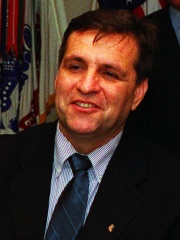
10. Boris Trajkovski (1956 - 2004)
With an HPI of 64.64, Boris Trajkovski is the 10th most famous Macedonian Politician. His biography has been translated into 45 different languages.
Boris Trajkovski (GCMG; Macedonian: Борис Трајковски, pronounced ['bɔris 'trajkɔfski] ; 25 June 1956 – 26 February 2004) was a Macedonian politician who served as the president of Macedonia from 1999 until his death in 2004 in a plane crash.
People
Pantheon has 42 people classified as Macedonian politicians born between 370 and 1987. Of these 42, 24 (57.14%) of them are still alive today. The most famous living Macedonian politicians include Gjorge Ivanov, Stevo Pendarovski, and Nikola Gruevski. The most famous deceased Macedonian politicians include Justinian I, Justin I, and Theodahad. As of April 2024, 5 new Macedonian politicians have been added to Pantheon including Hristijan Mickoski, Danela Arsovska, and Antonio Milošoski.
Living Macedonian Politicians
Go to all RankingsGjorge Ivanov
1960 - Present
HPI: 65.26
Stevo Pendarovski
1963 - Present
HPI: 62.52
Nikola Gruevski
1970 - Present
HPI: 60.20
Talat Xhaferi
1962 - Present
HPI: 56.84
Vlado Bučkovski
1962 - Present
HPI: 56.20
Zoran Zaev
1974 - Present
HPI: 55.09
Ali Ahmeti
1959 - Present
HPI: 54.91
Srgjan Kerim
1948 - Present
HPI: 54.90
Hristijan Mickoski
1977 - Present
HPI: 52.85
Ljubčo Georgievski
1966 - Present
HPI: 51.85
Hari Kostov
1959 - Present
HPI: 50.83
Dimitar Kovačevski
1974 - Present
HPI: 49.39
Deceased Macedonian Politicians
Go to all RankingsJustinian I
482 - 565
HPI: 85.69
Justin I
450 - 527
HPI: 76.33
Theodahad
480 - 536
HPI: 70.71
Kiro Gligorov
1917 - 2012
HPI: 70.24
Nexhmije Hoxha
1921 - 2020
HPI: 68.78
Sigeric
370 - 415
HPI: 68.04
Agron
HPI: 66.48
Konstantin Tih
1240 - 1277
HPI: 65.45
Boris Trajkovski
1956 - 2004
HPI: 64.64
Lazar Koliševski
1914 - 2000
HPI: 64.52
Fethi Okyar
1880 - 1943
HPI: 63.26
Lazar Mojsov
1920 - 2011
HPI: 61.28
Newly Added Macedonian Politicians (2025)
Go to all RankingsHristijan Mickoski
1977 - Present
HPI: 52.85
Danela Arsovska
1979 - Present
HPI: 45.01
Antonio Milošoski
1976 - Present
HPI: 39.44
Predrag Samardžiski
1986 - Present
HPI: 35.86
Vojdan Stojanovski
1987 - Present
HPI: 33.27
Overlapping Lives
Which Politicians were alive at the same time? This visualization shows the lifespans of the 12 most globally memorable Politicians since 1700.


